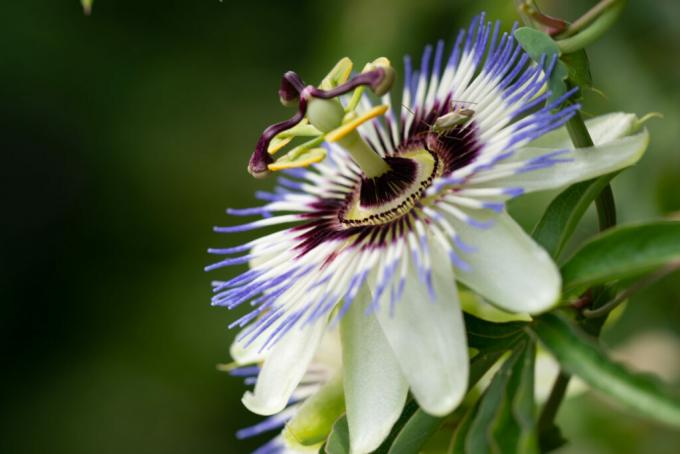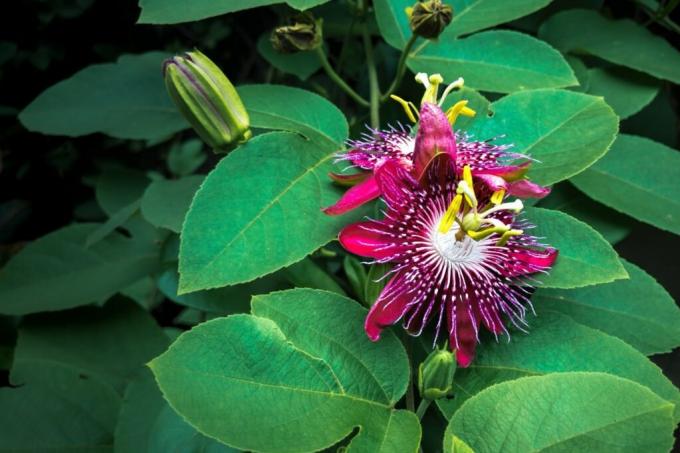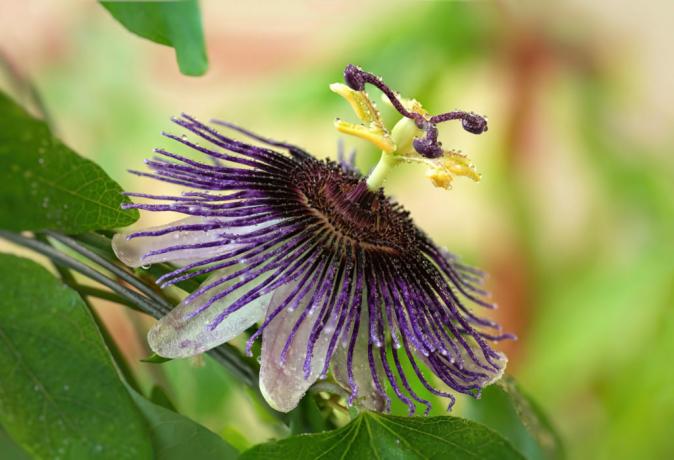The unusual flowers of the exotic cast a spell on everyone. We show what you should consider when planting and caring for the passion flower in the garden.

The extravagant blossoms of the passion flower (passiflora) not only leave room for inspiration, but are also a real eye-catcher in your own garden. They are available in different colors and shapes and you will surely find the right one for you. Some species of passionflower even bear edible fruit, while others are known for their medicinal properties. Let yourself be surprised by the versatility of passion flowers.
contents
- Passion flower: origin and properties
- Passiflora Species
- Buy passion flowers
-
Plant passion flower
- The right location for passion flowers
- Procedure for planting passion flowers
-
Cultivate passion flower
- Water passion flowers
- Fertilize passion flowers
- Cut passion flowers
- Passion flower does not bloom
- Overwinter passionflower
- Passion Flower Fruit: Harvest and Application
- Passion flower herb: application and effect
With their unusual flower shape, the passion flowers astonished the early immigrants to the American continent. The strikingly colored wreath of receding stamens reminded them of Christ's crown of thorns and the three dark styli of the nails with which Jesus was nailed to the cross. This is how the eccentric-looking flower was given a name that is characterized by suffering.
Passion flower: origin and properties
With over 400 species, the genus of passion flowers is very diverse. A majority of passion flower species are native to Central and South America, with another 25 species native to Australia, Oceania, Southeast Asia and North America. The mostly climbing plants are therefore at home in the tropics. To camouflage themselves, passionflowers often employ an intriguing strategy. In some way, the plants manage to recognize the leaf shape of the neighboring plants. Clever passion flowers then adopt these leaf shapes for their own leaves so as not to stand out among the other plants. This behavior can go so far that a passion flower has a wide variety of leaves. However, in view of such a conspicuous flower, will the camouflage succeed? To be on the safe side, passion flowers store prussic acid glycosides in their leaves as a stomach poison. Their fruits, on the other hand, are edible in most species and are referred to as granadilla or passion fruit. The passion fruit is also included.

Passiflora Species
Particularly well-known among the passion flowers is the edible and sweet-tasting maracuja (Passiflora edulis format flavicarpa). Their fruits are sold in many supermarkets and you can also discover them in some gardens. As an ornamental plant, however, the blue passion flower (Passiflora caerulea) spread. Their fruits are also edible, but are not considered particularly tasty. Basically, only the flesh-colored passion flower (Passiflora incarnata) a role. Its leaves are used as a passion flower herb in natural medicine.
Since passion flowers come from the tropics, most species are unfortunately not hardy. However, the blue passion flower, the most common commercially available type of passion flower in Germany, is relatively frost-resistant. It can survive the frosty season in milder areas of Central Europe, but freezes above ground in cold winters and sprout again in spring. However, their roots should be protected with brushwood in winter.
Want more about Hardy passion flower species find out, take a look at our special article here.
Buy passion flowers
If you would like to buy your own passion flower, the question naturally arises as to which type best suits your needs. The easiest to find in the German trade is the blue passion flower and its hybrids - such as the white-flowered one 'Constance Elliott'. Of course, these varieties have very beautiful flowers in a wide variety of color variations and still plus the advantage that they are relatively hardy and do not necessarily need to be overwintered indoors have to. Maracuja and purple granadilla, on the other hand, are both not particularly hardy and must be overwintered indoors. As a reward, both species bear tasty fruit. Whichever of the more than 400 species and countless hybrids you choose, they all have beautiful flowers. More about the Buying the right type of passion flower You can also find out in our special article.

Plant passion flower
Of course, not only the location is decisive for planting passion flowers, but also the substrate. In general, these plants are not particularly demanding, but the soil should be slightly acidic, with a pH between 5.8 and 6.8. The plants also like slightly humus-rich substrate that is well drained to prevent waterlogging. You can achieve this, for example, with pebbles that are placed at the bottom of the pot. For the nutrient requirements of passionflower, our peat-free Plantura organic potting soil ideally suited. It is also made from 100% natural raw materials and is harmless to humans and animals.
The right location for passion flowers
Since passion flowers come from the tropics, they like a warm and sunny location. This applies to keeping it indoors as well as outdoors. If you want to plant your passion flower outdoors and overwinter there, choose a sheltered location. For example, this can be near a larger bush, a wall or something similar. Also as climbing indoor plants Passion flowers that are kept look forward to a place outside in summer.
Procedure for planting passion flowers
Once you have found the right location and the right substrate is ready, you can start planting.

If you keep them in a pot or tub, repot your young passion flower in a slightly larger pot in spring. Choose a pot that is no more than 20 centimeters in diameter, otherwise the flower will invest less of its energy in the blossoms and more in the root and green matter. Once the flower has been planted, it definitely needs a climbing aid - whether indoors or outdoors. A trellis can be used for this purpose, for example.
Summary of planting passion flowers:
- Slightly acidic, humic substrate
- Drainage, for example, through pebbles at the bottom of the pot
- Sunny and warm location
- Choose a sheltered location outdoors
- Don't forget the climbing aid
Cultivate passion flower
As far as care is concerned, passion flowers are not very demanding. The most important thing is the right location and a regular supply of water. However, passion flowers that are kept indoors should be sprayed regularly with low-lime water. This protects against mites, who like to attack passion flowers when the air is too dry. More information about Care of passion flowers can also be found in our special article on the subject.
Water passion flowers
Passion flowers like it quite damp, but waterlogging damages the roots. Therefore, water regularly, but avoid waterlogging. Use low-lime water for watering, preferably rainwater.

Fertilize passion flowers
The growing season of the passion flower is between spring and autumn. During this time, fertilize the plant regularly about every 14 days. With a slow-release fertilizer like ours Plantura organic flower fertilizer Incidentally, this is only necessary about every two months, since the fertilizer only gradually becomes available to the plant and thus continuously supplies the plant with the most important nutrients. In winter, passion flowers remain dormant and do not require fertilization, since they do not grow either.
Cut passion flowers
Passion flowers bloom only on young shoots. You should therefore light out older specimens from time to time so that the passion flower puts its strength primarily in the young shoots. A cut back to 15 centimeters is easily possible and should be done in early spring or autumn.
Plants that are overwintered indoors can be pruned back, particularly at the sides, when they move into their winter quarters. Passion flowers that have overwintered outdoors usually freeze above ground. You can then remove the dead remains. more about Cutting passion flowers find out here.
Passion flower does not bloom
If a passion flower isn't blooming, chances are it's too dark or too cool. Therefore, choose a bright location that is also warm in summer. If possible, you should put the plant outside in the summer where it gets extra light. However, make sure that you first get the passion flower used to the sun so that its leaves do not get sunburnt. Another reason can be a pot that is too big so that the plant invests less in its flowers and more in its growth.
Overwinter passionflower
Most passionflower species do not survive the winter outdoors and should be overwintered indoors. The claims during the Overwintering the passion flower however, differ depending on the species. Most species need a cool but temperate and bright spot such as a conservatory in winter. The purple passion flower (Passiflora violacea), the vine-leaved or red passion flower (Passiflora vitifolia), the bay-leaved passion flower (Passiflora laurifolia) and the passion fruit, for example, prefer a temperature of around 10 °C. The white-blooded Passiflora eichleriana on the other hand, likes around 15 °C throughout the winter.
However, some species can also be overwintered outdoors as they have a certain degree of winter hardiness. However, only overwinter planted specimens outside, as the root ball tends to freeze through in pots and tubs. Cover the ground around the plant with brushwood and leaves to protect the roots. Fertilization is not necessary in winter and you should also reduce watering.
Passion Flower Fruit: Harvest and Application
If the conditions are right, passion flowers also produce fruit in local latitudes. But beware: Not all types of passion flowers have edible fruits. The fruits of edible species can be harvested as soon as they have turned orange to brown or purple. Fruits that are still green are poisonous and not suitable for consumption.

Here we have more details about fruit of the passion flower as well as edible and non-edible species for you.
Passion flower herb: application and effect
Flesh-colored passionflower leaves are believed to be calming and effective against insomnia and high blood pressure. They can be used as a homemade tea or tincture. Finished preparations such as tablets, teas and extracts are also commercially available. Find out more here Application and effect of the passion flower.

